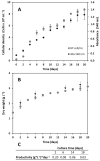Identification and Characterization of a Novel Microalgal Strain from the Antofagasta Coast Tetraselmis marina AC16-MESO (Chlorophyta) for Biotechnological Applications
- PMID: 37836113
- PMCID: PMC10574681
- DOI: 10.3390/plants12193372
Identification and Characterization of a Novel Microalgal Strain from the Antofagasta Coast Tetraselmis marina AC16-MESO (Chlorophyta) for Biotechnological Applications
Abstract
The wide rocky coastline of the Antofagasta hosts an intertidal ecosystem in which the species that inhabit it are routinely exposed to a wide range of physical and chemical conditions and have therefore evolved to tolerate extremes. In the search for new species of potential biotechnological interest with adaptations to a wide range of environmental conditions, the isolation and characterization of microalgae from these ecosystems is of great interest. Here, a new microalgal strain, Tetraselmis marina AC16-MESO, is described, which was isolated from a biofilm collected on the intertidal rocks of the Antofagasta coast (23°36'57.2″ S, 70°23'33.8″ W). In addition to the morphological characterization, 18S and ITS sequence as well as ITS-2 secondary structure analysis revealed an identity of 99.76% and 100% with the species Tetraselmis marina, respectively. The analyses of the culture characteristics and biochemical content showed similarities with other strains that are frequently used in aquaculture, such as the species Tetraselmis suecica. In addition, it is tolerant of a wide range of salinities, thus allowing its culture in water of varying quality. On the other hand, added to these characteristics, the results of the improvement of the lipid content in stressful situations of salinity observed in this study, together with other antecedents such as the potential in bioremediation already published for this strain by the same research group, present a clear example of its biotechnological plasticity. It is noteworthy that this strain, due to its characteristics, allows easy collection of its biomass by decantation and, therefore, a more cost-efficient harvesting than for other microalgal strains. Therefore, this new strain of Tetraselmis marina, first report of this species in Chile, and its morphologically, molecularly and biochemically description, presents promising characteristics for its use in biotechnology and as feed for aquaculture.
Keywords: biodiversity; biotechnology; chlorophyta; identification.
Conflict of interest statement
The authors declare no conflict of interest. The funders had no role in the design of the study; in the collection, analyses, or interpretation of data; in the writing of the manuscript; or in the decision to publish the results.
Figures









References
-
- Burlew J.S. Algal culture from laboratory to pilot plant. In: Muller H.J., editor. AIBS Bulletin. 5th ed. Volume 3. Carnegie Institution for Science; Washington, DC, USA: 1953. p. 11. - DOI
Grants and funding
LinkOut - more resources
Full Text Sources

